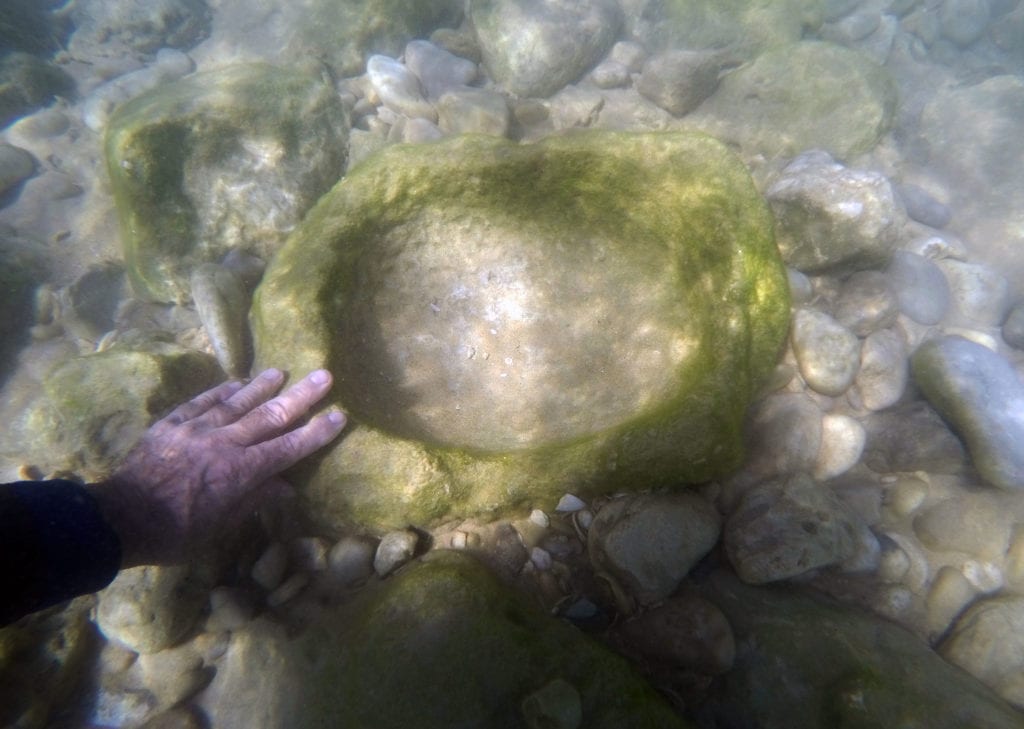With global warming causing the melting of the polar ice caps, numerous places around the world – most recently in Venice, Italy – are being flooded by rising waters. Yet, flooding from rising sea levels is not new. Researchers from the University of Haifa, Flinders University in Australia, the Hebrew University of Jerusalem and the Israel Antiquities Authority have discovered in northern Israel the remains of the most ancient sea wall in ancient history built against the rising of the seas caused by melting glaciers.

The last Ice Age some 20,000 years ago was followed by the melting of glaciers and the rise of the oceans and the seas. About 7,000 years ago, residents of a village at Tel Hreiz near the Carmel coast constructed a wall abut a meter in height to protect themselves caused by surging waters from the Mediterranean Sea. In archaeology, a tel (derived from the Hebrew and Arabic words for “hill”) is an artificial mound formed from the accumulated refuse of generations of people living on the same site for hundreds or thousands of years.
Some 7,000 years ago, during the Neolithic Period, residents of a village on the Carmel Coast built a wall to protect itself from the rising sea level caused by melting glaciers, But the inhabitants’ efforts eventually failed, and their village was covered with water, according to the research, which has just been published in the journal PLoS One.
Tel-Hariz, located next to the modern-day Kibbutz Hahotrim established in 1952 by Jewish refugees from Czechoslovakia and Germany, represents the earliest human testimony to attempt to build a defensive wall against rising sea levels. The ancient agricultural community, which survived for abut 200 years until it was finally covered with water, was comprised of 20 or 30 families or 100 to 150 people who raised livestock including cattle and pigs, grew wheat and fished. Originally the village was built on at an elevation of about three meters above sea level.
“It’s amazing to see how the same issues that concern us today with regard to rising sea level and the way to deal with it, also preoccupied our ancient ancestors about 7,000 years ago,” said Dr. Ehud Galili of the University of Haifa’s Zinman Institute of Archeology who led the study.
“Like today, the struggle against natural forces forced the entire community to come together and make tough decisions. In Tel Hreiz, the decision was to create an exceptional monument in terms of investment and resources compared to the rest of the village.”
Over the years, buildings, facilities and human and animal have been exposed at the archeological site, one of 14 flooded Neolithic settlements exposed in the Strip between Haifa and the Habonim coast.
About a year ago, researchers on the western side of the village, which is currently 80 meters deep in the sea and about 3.5 meters deep, discovered an unusual finding compared to the other 13 localities: a stone wall about 100 meters long and about a meter high, made up of rounded rocks.
Investigators say the straightforward shape and the fact that the wall is facing the beach imply that it is a type of sea wall that was erected to separate the ancient beach and the village, but there were other features. First, the size and weight of the rocks that formed the wall were exceptional at up to a ton each, compared to the stones weighing between 10 to 50 kilograms each that were used by the ancient villagers to build their houses. Second, the closest location of rocks of this size was in a stream about four kilometers from the village.
“We understand that, unlike other buildings in the village, the construction of the stone wall was a community-wide project. Only a large number of people could carry these heavy stones for so long, in a culture that did not know the wheel of course. Such mobilization implies that building the wall was very important to the villagers,” Galili said.
In light of all the evidence, the researchers believed that the purpose of the wall was to protect the village against the rise of the sea, which occurred at that time. According to them, during the Neolithic period, the Mediterranean rose four to seven millimeters each year or about 12 to 21 centimeters during a lifetime. People could still remember how, when they were young, a severe storm hit one village in several years while now, when they are older, three or four storms hit the village every year. This fact induced them to plan and build the huge project of a sea wall, Galili added.
“If the rate of sea level rise continues at a rate that some of the scientific community warns, we may as well go the way of our ancient ancestors. We will invest huge sums of money to try and fight the rising waters, and maybe, in the end we will also be forced to abandon some of the communities, the University of Haifa scientist concluded.



